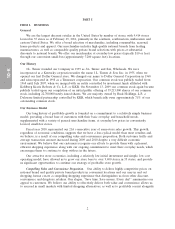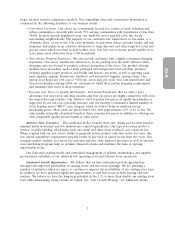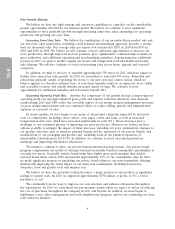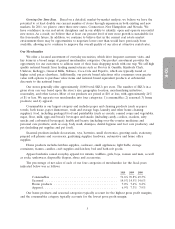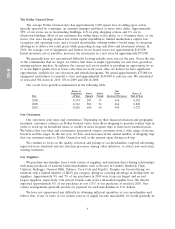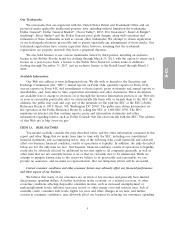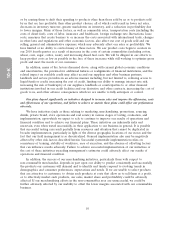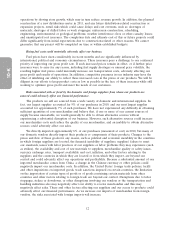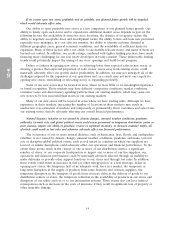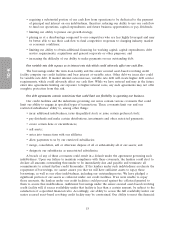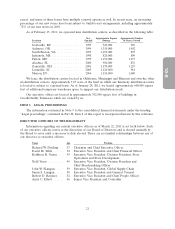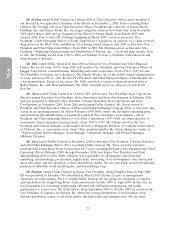Dollar General 2010 Annual Report Download - page 90
Download and view the complete annual report
Please find page 90 of the 2010 Dollar General annual report below. You can navigate through the pages in the report by either clicking on the pages listed below, or by using the keyword search tool below to find specific information within the annual report.
10-K
operations by slowing store growth, which may in turn reduce revenue growth. In addition, the planned
construction of a new distribution center in 2011, and any future distribution-related construction or
expansion projects, entail risks which could cause delays and cost overruns, such as: shortages of
materials; shortages of skilled labor or work stoppages; unforeseen construction, scheduling,
engineering, environmental or geological problems; weather interference; fires or other casualty losses;
and unanticipated cost increases. The completion date and ultimate cost of this or future projects could
differ significantly from initial expectations due to construction-related or other reasons. We cannot
guarantee that any project will be completed on time or within established budgets.
Rising fuel costs could materially adversely affect our business.
Fuel prices have risen considerably in recent months and are significantly influenced by
international, political and economic circumstances. These increases pose a challenge to our continued
priority of improving our gross profit rate. If such increased prices remain in effect, or if further price
increases were to arise for any reason, including fuel supply shortages or unusual price volatility, the
resulting higher fuel prices could materially increase our transportation costs, adversely affecting our
gross profit and results of operations. In addition, competitive pressures in our industry may have the
effect of inhibiting our ability to reflect these increased costs in the prices of our products. We will be
diligent in our efforts to keep product costs as low as possible in the face of these increases while still
working to optimize gross profit and meet the needs of our customers.
Risks associated with or faced by the domestic and foreign suppliers from whom our products are
sourced could adversely affect our financial performance.
The products we sell are sourced from a wide variety of domestic and international suppliers. In
fact, our largest supplier accounted for 9% of our purchases in 2010, and our next largest supplier
accounted for approximately 7% of such purchases. We have not experienced any difficulty in obtaining
sufficient quantities of core merchandise and believe that, if one or more of our current sources of
supply became unavailable, we would generally be able to obtain alternative sources without
experiencing a substantial disruption of our business. However, such alternative sources could increase
our merchandise costs and reduce the quality of our merchandise, and an inability to obtain alternative
sources could adversely affect our sales.
We directly imported approximately 8% of our purchases (measured at cost) in 2010, but many of
our domestic vendors directly import their products or components of their products. Changes to the
prices and flow of these goods for any reason, such as political and economic instability in the countries
in which foreign suppliers are located, the financial instability of suppliers, suppliers’ failure to meet
our standards, issues with labor practices of our suppliers or labor problems they may experience (such
as strikes), the availability and cost of raw materials to suppliers, merchandise quality or safety issues,
currency exchange rates, transport availability and cost, inflation, and other factors relating to the
suppliers and the countries in which they are located or from which they import, are beyond our
control and could adversely affect our operations and profitability. Because a substantial amount of our
imported merchandise comes from China, a change in the Chinese currency or other policies could
negatively impact our merchandise costs. In addition, the United States’ foreign trade policies, tariffs
and other impositions on imported goods, trade sanctions imposed on certain countries, the limitation
on the importation of certain types of goods or of goods containing certain materials from other
countries and other factors relating to foreign trade are beyond our control. Disruptions due to labor
stoppages, strikes or slowdowns, or other disruptions involving our vendors or the transportation and
handling industries also may negatively affect our ability to receive merchandise and thus may
negatively affect sales. These and other factors affecting our suppliers and our access to products could
adversely affect our financial performance. As we increase our imports of merchandise from foreign
vendors, the risks associated with foreign imports will increase.
12


